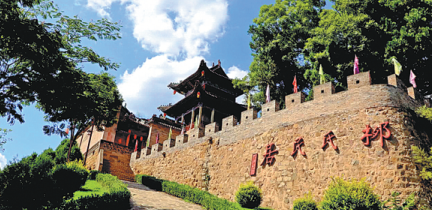Family leaves spiritual legacy and landmark

The Liu's Residence is surrounded by a wall resembling that of the Forbidden City. [Photo by Wang Pei for China Daily]
For thousands of years, culture has been used in China to gauge whether a place is suitable for people to live in, especially when they are trying gain prosperity and fortune for their families.
This is especially true in Shanxi province, which is believed by many to be one of the cradles of Chinese culture. Its prosperous culture has been embodied in its great number of ancient structures, monuments and historical remains as well as rich folk arts, traditions and customs, not only in big cities but remote villages too.
One such village is Wenxing in the county of Qinshui in the southeast of Shanxi. Located at the heart of the Taihang Mountains, Wenxing is home to a large residential complex that was built during the Ming (1368-1644) and Qing (1644-1911) dynasties.
The complex is called Liu's Residence. More than 90 percent of the population in Wenxing belongs to the Liu family.
According to the Liu family's history book, their ancestor was Liu Zongyuan. He was a renowned writer, poet and statesman in the Tang Dynasty (618-907).
The book said he was a political activist during the middle period of Tang, who implemented sweeping reforms of Chinese bureaucracy. But a taxation system reform brought him into conflict with the aristocracy. As a result, Liu Zongyuan was demoted to some remote regions in China. His family members had to move to Wenxing village to escape persecution.
The Liu family regained prosperity 500 years later during the Ming and Qing dynasties. Following the instructions of Liu Zongyuan, the family had lived as both farmers and scholars. Some had become successful officials and businesspeople, accumulating substantial fortunes. They began the massive construction of a residential complex in the Ming Dynasty. At its peak, the complex featured 13 courtyards.
Today, 12 courtyards are preserved and eight of them are intact. The largest covers about 1,200 square meters. The complex is surrounded by a long wall, which bears a resemblance to the one surrounding the Forbidden City.
In addition to residential buildings, there are public buildings including the Temple of Guandi, the Tower of Kuixing and the Tower of Wenchang.
Guandi is the deification of the renowned ancient Chinese general Guan Yu, who was known for his courage and faith toward his country. Kuixing is the legendary constellation responsible for education, and Wenchang literally means cultural prosperity. Locals say the three buildings represent the residents' hopes to cultivate versatile talents for their children.
The most prominent among all the public buildings is the ancestral temple devoted to Liu Zongyuan. With a statue of Liu in front of the gate and his instructions inscribed on stone slabs, this is the most sacred place in the village.
Guo Yanjie contributed to this story.



